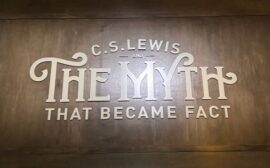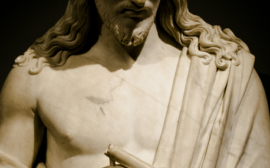By Steven Johnson, DDS | May 25, 2025
Saul Persecuted Christians
The Biblical account of Saul, later to be called Paul, began with Stephen being arrested. Stephen was called “a man of faith and of the Holy Spirit” (Acts 6:5) and “full of grace and power, was doing great wonders and signs among the people” (Acts 6:8). Stephen gave a speech before the high priests, and later they threw him out of the city and stoned him. Saul was there and heard and saw this all happen, and he approved what they did to Stephen; in Acts 8:3, “But Saul was ravaging the church, and entering house after house, he dragged off men and women and committed them to prison.” The new believers in Jesus were scattered, but they told others about Jesus wherever they went.
Saul Converts to Christianity and Becomes Paul
Acts 9 is the first of 3 accounts of Saul’s conversion. He was on his way to Damascus with a letter from the high priest to arrest men and women who were following Jesus’ teachings. In this account, it says suddenly, a light from heaven shone around him, and he heard a voice saying, Saul, why are you persecuting Me? And Saul responded, “Who are you, Lord?” The other men with Saul saw the light and were speechless; they also heard the voice but saw no one. The second account in Acts 22 of Paul’s conversion was after he was arrested, and he addressed the people. He told them how he was educated and was zealous for God, as were the people who were now trying to kill him. He said the same thing as the first account but added, “What should I do, Lord?” In the third account, he stood before King Agrippa in Acts 26. In this account, he tells King Agrippa the same story but adds a few new details: verses 14-18—He said I heard a voice saying to me in the Hebrew language, ‘ I am Jesus whom you are persecuting…. who are sanctified by faith in me.” In verses 19-31, he tells the king what he has done.
Saul to Paul: An Actual Event or Hallucination
Skeptics of Christianity propose theories regarding Paul’s encounter with Christ. Some say Paul was hallucinating. In short, hallucinations are false perceptions about what is not present in the real world, which are often not maintained vociferously when the evidence is pointed out. The mistake is often quickly acknowledged. (1) Hallucinations are generally private events. In 1 Cor. 15: 1-11, Paul describes all the appearances of Jesus, including his own, and how he changed:” For I am the least of the apostles, unworthy to be called an apostle because I persecuted the church of God. But by the grace of God… I worked harder than any of them, though it was not I, but the grace of God that is with me. Whether then it was they or I, some preach, and so you believed (1 Cor. 15:9-11). Also, hallucinations usually don’t involve multiple senses, like when Paul saw a bright light and heard Jesus’ voice. In addition, other non-believers with Paul saw the bright light and listened to the voice, but didn’t understand it. Hallucinations generally don’t transform lives, and if they do, it is short-lived, unlike Paul, who went from persecuting people who believed in the risen Jesus to putting his life on the line to say Jesus did rise from the dead. Ultimately, Paul was martyred for his beliefs.
Furthermore, Jesus’ body was no longer in the grave. That brings up another key point: if it was a hallucination, Jesus’ body should still be in the grave. There has never been anyone who has produced Jesus’ body. After Paul’s conversion, he went to Jerusalem and met with the other key disciples to investigate their accounts (Gal. 1:18-19 and 2:1-10). After hearing their details, Paul confirmed that the other apostolic eyewitnesses to the appearances of the risen Jesus were also teaching precisely what he regarded as the truth and nature of these events, so much so that Paul told his readers that they would get the same answers if any of the apostles were asked for details (1 Cor 15:11). Paul states these comments carefully too, immediately after providing the creedal list of appearances in which the other apostles like Peter and James had also participated (1 Cor 15: 3-7). (2) Also, the New Testament authors regularly differentiated between the resurrection appearances of Jesus and other sorts of heavenly visions. Examples of non-resurrection visions could include visionary phenomena such as Jesus’s transfiguration (Mark 9:2-8; Matt 17:1-8; Luke 9:28-36), Stephen’s martyrdom vision of the exalted Jesus (Acts 7:55-56), Peter’s vision of the large sheet of animals coming down from heaven (Acts 10:9-16), or other visions reported by Paul (Acts 16:9). (3)
Conclusion
To conclude, Paul is recorded in Acts as saying Jesus’ body didn’t decay as King David’s did in the grave. Implying that Jesus’ body was resurrected literally. In Acts, Luke describes the appearance of Jesus to Paul differently than his appearance to the disciples. All the other appearances of Jesus were before Jesus ascended into heaven, and Paul’s was after Jesus went to heaven. But this doesn’t mean Paul was hallucinating. First, this doesn’t mean Paul’s experience was only in his mind since he saw a bright light and heard Jesus’ distinct words. Also, other non-believers with Paul saw the bright light and heard a voice. Secondly, Paul’s experience, though different from the other appearances of Jesus, resurrection, still shows in Acts 13 that Paul believed he saw Jesus bodily resurrected. Third, Luke didn’t think there was a problem between Paul’s encounter and the other encounters recorded prior to Jesus’ ascending into heaven, since he recorded both appearances (Luke 24; Acts 1:1-11). Finally, Acts was written after Matthew, Mark, and Luke. The Gospels tell in detail about them seeing, touching, and eating with Him. So, if there is an evolution of the nature of appearances, it goes in the opposite direction: bodily to vision. This observation is strengthened all the more when we consider that the earliest of those commenting on Jesus’ resurrection, Paul, strongly hints at its bodily nature. (4)
Going Deeper
If you are interested in a deeper study of the Resurrection of Jesus. There are several good books on the subject: On the Resurrection: Vol.1 Evidence by Gary Habermas, On the Resurrection: Vol.2 Refutations by Gary Habermas, Philosophy of History, Miracles, and the Resurrection of Jesus (Third Edition) by Gary R. Habermas, The Case for the Resurrection of Jesus by Gary R. Habermas and Michael R. Licona, The Big Book of Christian Apologetics by Norman L Geisler, and In Defense of Miracles edited by R. Douglas Geivett and Gary R. Habermas.
About the Author

Steven served 36 years as a dentist in his hometown of Buffalo Center, Iowa before retiring from his practice. He is a graduate of the University of Iowa Dental School in 1987. He currently resides in Mankato, Minnesota. Dr. Johnson is a devout disciple of Christ. He faithfully attends Wooddale Church of Eden Prairie, Minnesota. Steven was the husband of our late beloved Dr. Michelle Johnson
Dr. Johnson’s desire is to continue to honor Michelle with the passion she held so dear–writing articles that glorify God. He hopes to offer believers further reasons to trust in the risen Savior and desires to share the gospel with the lost, prompting them to accept Christ as their Savior.
Notes
(1)Gary R. Habermas, On the Resurrection: Vol. 2 Refutations, B&H Academic, 649.
(2)Gary R. Habermas, On the Resurrection: Vol.1Evidences, B&H Academic,593.
(3)Gary R. Habermas, On the Resurrection: Vol. 2 Refutations, B&H Academic, 697.
(4)Gary R Habermas and Michael R. Licona, The Case for the Resurrection of Jesus, Kregel Publications, 156-157.






Does god want any 21st century person to read the book of Acts?